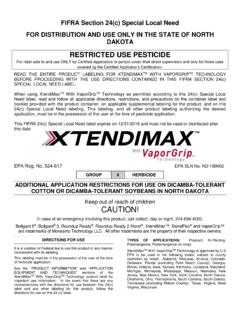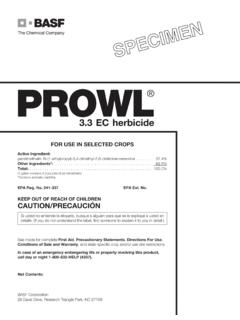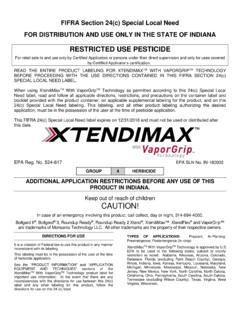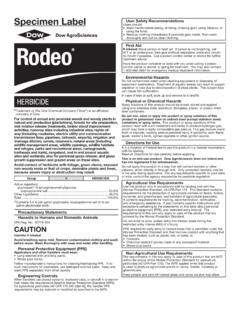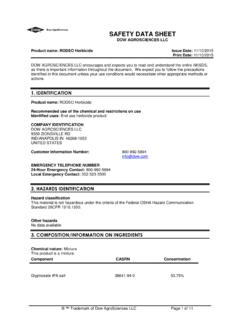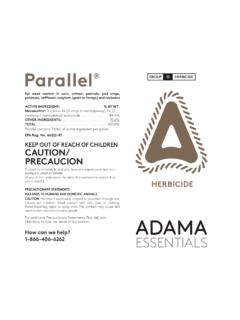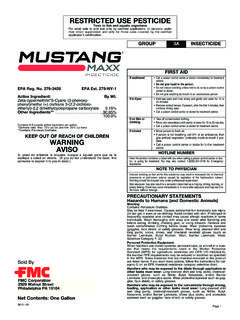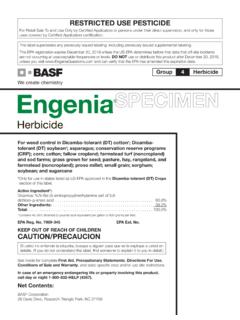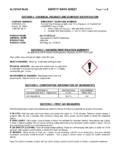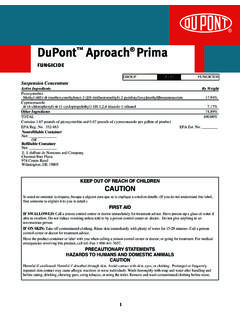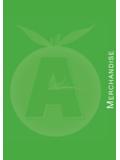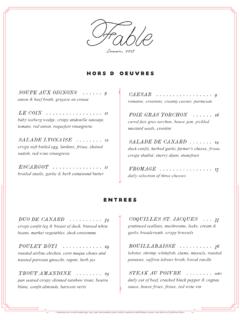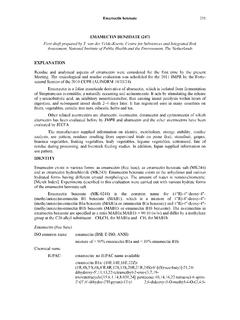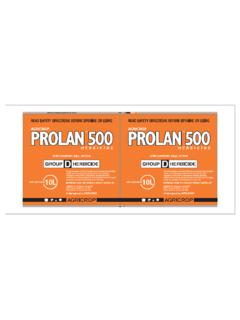Transcription of Nufarm T-Methyl 4.5 F - CDMS
1 SPECIMENACTIVE INGREDIENT: Th iophanate-methyl (Dimethyl [(1,2-phenylene)bis(iminocarbonothioyl)] bis[Carbamate])* .. INGREDIENTS: .. : .. *Also known as Dimethyl 4,4 -o-phenylenebis[3-thioallophanate]Contai ns pounds thiophanate-methyl per gallonKEEP OUT OF REACH OF CHILDRENCAUTION/PRECAUCI NSee Inside Label Booklet for FIRST AID, PRECAUTIONARY STATEMENTS, and Complete DIRECTIONS FOR USEFor Chemical Spill, Leak, Fire, or Exposure, Call CHEMTREC (800) 424-9300 For Medical Emergencies Only, Call (877) 325-1840 EPA REG. NO. 228-652 Manufactured forNufarm Americas S. Austin AvenueAlsip, IL 60803T-Methyl FFungicideNufarm2 SPECIMEN2 FIRST AIDIf swallowed: Call a poison control center or doctor immediately for treatment advice. Have person sip a glass of water if able to swallow. Do not induce vomiting unless told to do so by a poison control center or doctor.
2 Do not give anything by mouth to an unconscious inhaled: Move person to fresh air. If person is not breathing, call 911 or an ambulance, then give artificial respiration, preferably by mouth-to-mouth, if possible. Call a poison control center or doctor for further treatment on skin or clothing: Take off contaminated clothing. Rinse skin immediately with plenty of water for 15-20 minutes. Call a poison control center or doctor for treatment in eyes: Hold eye open and rinse slowly and gently with water for 15-20 minutes. Remove contact lenses, if present, after the first 5 minutes, then continue rinsing eye. Call a poison control center or doctor for treatment NUMBERHave the product container or label with you when calling a poison control center or doctor, or going for treatment. You may also contact 1-877-325-1840 for emergency medical treatment STATEMENTSHAZARDS TO HUMANS AND DOMESTIC ANIMALSCAUTION / PRECAUCI NHarmful if swallowed, inhaled or absorbed through skin.
3 Causes moderate eye irritation. Avoid contact with skin, eyes or clothing. Avoid breathing vapor or spray mist. Personal Protective Equipment (PPE)Some materials that are chemical-resistant to this product are barrier laminate, butyl rubber 14 mils, nitrile rubber 14 mils, polyvinyl chloride (PVC) 14 mils, and viton 14 mils. If you want more options, follow the instructions for category C on an EPA chemical-resistance category selection mixing, loading and applying the product as a dip (including application of product in Kaolinite clay to conifer seedling roots) must wear: Coveralls over long-sleeved shirt and long pants, Chemical-resistant gloves, Chemical-resistant footwear plus socks, Chemical-resistant apronAll other mixers and loaders and applicators must wear: Long-sleeved shirt and long pants, Shoes plus socks, Chemical-resistant gloves for all mixers and loaders and for applicators using hand held equipment, and Chemical-resistant apron for mixers, loaders and other handlers exposed to the Safety RequirementsFollow manufacturer s instructions for cleaning/maintaining PPE.
4 If no such instructions for washables exist, use detergent and hot water. Keep and wash PPE separately from other laundry. Discard clothing and other absorbent materials that have been drenched or heavily contaminated with this product s concentrate. Do not reuse ControlsWhen handlers use enclosed cabs in a manner that meets the requirements listed in the Worker Protection Standard (WPS) for agricultural pesticides (40 CFR (d)(4-6)), the handler PPE requirements may be reduced or modified as specified in the SAFETY RECOMMENDATIONSU sers should: Wash hands before eating, drinking, chewing gum, using tobacco, or using the toilet. Remove clothing/PPE immediately if pesticide gets inside. Then wash thoroughly and put on clean clothing. Remove PPE immediately after handling this product. Wash the outside of gloves before removing.
5 As soon as possible, wash thoroughly and change into clean HAZARDSDo not apply directly to water, or to areas where surface water is present or to intertidal areas below the mean high water mark. Runoff from treated areas may be hazardous to aquatic organisms in neighboring areas. Do not contaminate water by disposing of equipment FOR USEIt is a violation of Federal law to use this product in a manner inconsistent with its labeling. Do not apply this product in a way that will contact workers or other persons, either directly or through drift. Only protected handlers may be in the area during application. For any requirements specific to your State or Tribe, consult the agency responsible for pesticide USE REQUIREMENTSUse this product only in accordance with its labeling and with the Worker Protection Standard, 40 CFR part 170.
6 This standard contains requirements for the protection of agricultural workers on farms, forests, nurseries, and greenhouses, and handlers of agricultural pesticides. It contains requirements for training, decontamination, notification, and emergency assistance. It also contains specific instructions and exceptions pertaining to the statements on this label about personal protective equipment (PPE), notification to workers, and restricted-entry interval. The requirements in this box apply to uses of this product that are covered by the Worker Protection not enter or allow worker entry into treated areas during the following restricted entry intervals (REI):Check the Application Directions table for the correct REI for each crop. If the table does not list an REI for a particular crop, the REI is 12 required for early entry to treated areas (that is permitted under the Worker Protection Standard and that involves contact with anything that has been treated, such as plants, soil, or water), is: Coveralls over long-sleeved shirt and long pants Chemical-resistant gloves made of any waterproof material Chemical-resistant footwear plus socks Chemical-resistant headgear for overhead exposure4 SPECIMEN4 PRODUCT INFORMATIONA pply this product with ground or aerial equipment, using sufficient volume of spray to provide thorough coverage.
7 Continuous agitation is required to keep the material in suspension. Do not tank mix this product with highly alkaline pesticides, such as Bordeaux mixture or lime sulfur. No claim of compatibility with other pesticides is implied. Use the higher rates under conditions of severe disease pressure. Also, see local State Extension Service instructions for application disease control occurs when fungicides are applied in a preventative spray program prior to fungal infection. Some diseases are better controlled when several different MOA (Modes of Action) fungicides are tank-mixed for the application. Check your area University or Extension Recommendations Guide for the fluid rate for concentrate sprays (less than 400 gallons on apples, less than 300 gallons on stonefruit). Use the fluid gal rate for dilute ground applications.
8 For aerial applications, use a minimum of 3 gallons/A (5 gallons/A in California) for row crops, and a minimum of 10 gallons/A for tree crops. Higher spray volume will generally result in better coverage and better disease on non-bearing apples, pecans, cherries, and peaches: Use this product for control of the leaf diseases listed on the label for these crops during the non-bearing years of new plantings, and on nursery stock. All use directions and limitations must be followed, except for the PHI, which is not applicable. Begin applications as disease is first observed. Tank mix with a protectant fungicide for resistance instructions follow. Do not apply through any irrigation system unless these instructions are Management: To avoid the development of tolerant or resistant strains of fungi, tank mix this product with a fungicide of different chemistry, and/or alternated with a fungicide of different chemistry at each application.
9 If after using this product as specified in this label, the treatment is not effective, a tolerant or resistant strain of fungi is likely present. Discontinue the use of this product for at least one season. Do not use products containing thiabendazole or other products containing thiophanate-methyl as substitutes for this product, as they are of similar chemistry and will contribute to the development of resistance. As long as these precautions are followed, this product can be useful for disease control, even if resistant strains are INSTRUCTIONSA lways start with a thoroughly clean spray tank and spray system before using this spray tank to half full, start agitation. Be sure to shake product container well before pouring to measure. Slowly pour required amount into spray tank, then finish filling tank with water, all the while maintaining mix this product with other pesticides to broaden spectrum of control.
10 Using instructions above, add products in order of formulation type: dry flowables (DF), wettable powders (WP), and wettable dry granules (WDG) should be added first; then flowables (F and SC); then emulsifiable concentrates (EC) last. As each product is added to the tank, be sure it is completely dispersed before adding any other product to the mix. Maintain agitation throughout mixing and application there is any question as to the compatibility of the components, always perform a jar test with proportional amount of each product, using water from the actual use source. Always read and follow label direction of all products. The most restrictive label language will apply. Do not mix more spray solution than you plan to apply that DIRECTIONS TABLENote: Dilute sprays are not to exceed maximum rate per NAMEFLUID (LB AI/ACRE)FLUID GALUSE INFORMATIONA lmondsBrown rot Blossom blightScabJacket RotLeaf BlightMonilinia , Sclerotinia, BotrytisSeimatosporium20 - 30( - lb ai/A)Apply at pink bud and petal :Do not enter or allow worker entry into treated areas during the restricted entry interval (REI) of 3 not apply more than 60 fl.
